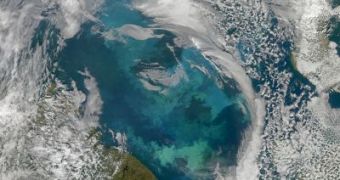A new image acquired by NASA's Moderate Resolution Imaging Spectroradiometer (MODIS) on the Aqua satellite, shows phytoplankton blooming in the Barents Sea.
The image was taken August 31 and it show the brightest shades of turquoise, navy, teal and green shrouding the sea waters, just like an ever changing abstract painting.
The “painter” is a massive phytoplankton bloom containing millions of small, light-reflecting organisms that grow in the surface waters of the Barents Sea, every year in the month of August.
The colors are so different because of the mix of different species of phytoplankton, and different concentrations of these species.
Normally, coccolithophores - a type of phytoplankton that is coated in a chalky shell that reflects light, turning the ocean a milky turquoise, give the bright blue colors; they are also the predominant species during the month of August.
Diatoms, another type of phytoplankton that normally are predominant in the Barents Sea earlier in the year, give the waters shades of green.
During the late summer, diatoms make place for coccolithophores, but field measurements or August blooms from previous years showed high concentrations of diatoms.
This change between the diatoms and the coccolithophores occurs during the summer months, as the sea changes its temperature.
In summer, the sunlight is gradually warming the surface of the waters, until the ocean starts having a layer of warm water on top of a layer of cold water.
That's when the diatoms stop growing because most of their nutrients are lost in surface waters; coccolithophores on the other hand, love warm waters, full of nutrients and with lots of light, like the conditions in the Barents Sea in August.
The basin of the Barents Sea is rather shallow and the currents that carry warm, salty water from the Atlantic are colliding with currents carrying cols, fresher water from the Arctic, and during the winter period, strong winds mix the currents.
The Barents Sea is located between the coastline of northern Russia and Scandinavia and the islands of Svalbard, Franz Josef Land, and Novaya Zemlya.

 14 DAY TRIAL //
14 DAY TRIAL //